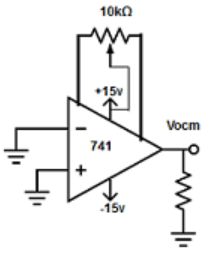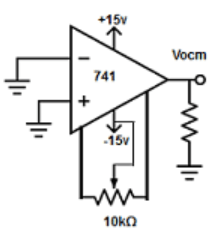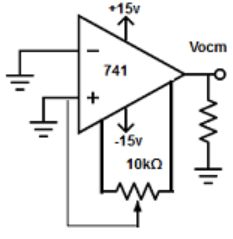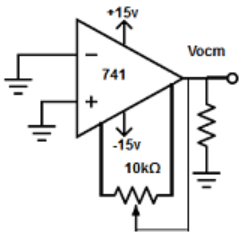This set of Linear Integrated Circuit Multiple Choice Questions & Answers (MCQs) focuses on “Input Offset Voltage – 1”.
1. What makes the output voltage equals to zero in practical op-amp?
a) Input offset voltage
b) Output offset voltage
c) Offset minimizing voltage
d) Error voltage
View Answer
Explanation: Input offset voltage is the differential input voltage that exists between two input terminals of an op-amp without any external input and force the output voltage to zero.
2. What happens due to mismatch between two input terminals in an op-amp?
a) Input offset voltage
b) Output offset voltage
c) Bothe the input and output offset voltage
d) None of the mentioned
View Answer
Explanation: The input offset voltage in op-amp force the output voltage to zero due to the mismatch between two input terminal, there will be voltage produced at the output and this voltage is called output offset voltage.
3. Define polarity of the output offset voltage in a practical op-amp?
a) Positive polarity
b) Negative polarity
c) Positive or negative polarity
d) None of the mentioned
View Answer
Explanation: The output offset voltage is a DC voltage, it may be positive or negative in polarity depending on whether the potential difference between two input terminal is positive or negative.
4. The input offset voltage of 741 op-amp has an absolute maximum value of 6mv, which means
a) Minimum difference between input terminals in 741 op-amp can be large as 6mv DC
b) Minimum difference between input terminals in 741 op-amp can be large as 6mv AC
c) Maximum difference between input terminals in 741 op-amp can be large as 6mv DC
d) Maximum difference between input terminals in 741 op-amp can be large as 6mv AC
View Answer
Explanation: Given, the absolute maximum value for a 741 is Vio= 6mv. Therefore, voltage at the non-inverting input terminal may differ from that at the inverting input terminal by as much as 6mv dc. Also the output offset voltage is a DC voltage and it cannot be AC voltage.
5. If three different 741 op-amps are taken and the corresponding output offset voltage for each of them is measured. The output voltage in these three op-amps have
a) Same amplitude and polarity
b) Different amplitude and polarity
c) Same amplitude and different polarity
d) Different amplitude and same polarity
View Answer
Explanation: Even though the op-amps are of the same type, the output voltage in these three op-amps are not of the same amplitude and polarity, because of mass production.
6. To reduce the output offset voltage VooT to zero
a) Input offset voltage compensating network is added at the inverting input terminal
b) Input offset voltage compensating network is added at the non-inverting input terminal
c) Input offset voltage compensating network is added at the output terminal
d) None of the mentioned
View Answer
Explanation: To reduce the VooT to zero, the external circuit is added at the input terminal of the op-amp that will give the flexibility of obtaining input offset voltage of proper amplitude and polarity. The input terminal can be inverting or non-inverting.
7. Which of the following op-amp does not need compensating network?
a) 777
b) 741
c) 748
d) All of the mentioned
View Answer
Explanation: The compensating network is not needed for these op-amps because, they have offset null pins.
8. Find out the voltage offset null circuit for the 741 op-amp?
a)

b)

c)

d)

View Answer
Explanation: For 741-type op-amp, the manufacturer recommend a 10kΩ potentiometer be placed across offset null pin1 and 5 and a wiper be connected to the negative supply pin 4. Null output is obtained by adjusting the pot.
9. What will the condition of op-amp, before applying any external input
a) Compensated
b) Biased
c) Balanced
d) Zero
View Answer
Explanation: Before applying external input to the op-amp, the output offset voltage should be reduced to zero with the help of an offset voltage compensating network. At this condition, the op-amp is said to be balanced or nulled.
Sanfoundry Global Education & Learning Series – Linear Integrated Circuits.
To practice all areas of Linear Integrated Circuits, here is complete set of 1000+ Multiple Choice Questions and Answers.
If you find a mistake in question / option / answer, kindly take a screenshot and email to [email protected]
- Apply for Electronics & Communication Engineering Internship
- Check Electrical Engineering Books
- Practice Electronics & Communication Engineering MCQs
- Apply for Electrical Engineering Internship
- Practice Electrical Engineering MCQs
